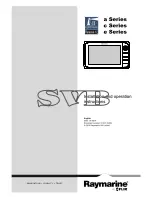
Problem
Cause
Solution
(bring the hammer to an
authorized workshop)
The hammer stops after
few blows, after being re-
installed on the excavator.
Dirt entered into the hammer
through the rubber hoses.
Take down the hammer, clean and
eventually change the damaged
components.
Oil leaking from the tool.
Seals are worn out. Marks on
the piston surface.
Replace seals and other damaged
parts.
The hammer beats with a
weak penetration force
and there are too many
vibrations on the high
pressure rubber hose.
The accumulator has lost the
pre-charge or the diaphragm
is broken.
Restore the correct pressure.
In other cases, replace the
diaphragm and restore the right
nitrogen pressure.
The hammer increases the
number of blows, but the
power decreases.
The tool support seat (support
ring) is worn out. The piston
shortens its stroke.
Make sure that the tool support seat
(support ring) is intact. So to operate
as follows:
1) Lay the hammer on the ground
and trace a mark on the tool at the
level of the bush end.
2) Remove the tool and make sure
that the value between the mark and
the plate end of the tool is lower or
equivalent to the one indicated in the
technical specifications. If higher, it
is necessary to change the support
ring immediately.
One of the tie rod bolts is
broken or loosened.
The working pressure is to
high.
Ask to a technical service to change
it (it is always suggested to replace
all 4 tie rod bolts) or to tighten it well
at the correct torques (see technical
specifications – tightening values).
Check the oil flow to the hammer.
CLEANING, MAINTENANCE AND CHECKS
22
Page
of 48
5
Nederland B.V.
Summary of Contents for MDO 1600 TS
Page 34: ...44 39 41 43 45 36 35 38 40 42 46 37 STROKE CHANGER 34 Page of 48 10 Nederland B V ...
Page 40: ...101 96 98 100 99 97 DISTRIBUTOR GROUP 40 Page of 48 13 Nederland B V ...
Page 42: ...107 104 106 101 105 109 108 103 102 ACCUMULATOR GROUP 42 Page of 48 14 Nederland B V ...
Page 46: ...129 132 125 134 127 128 126 133 130 133 131 GREASING SYSTEM 46 Page of 48 16 Nederland B V ...
















































